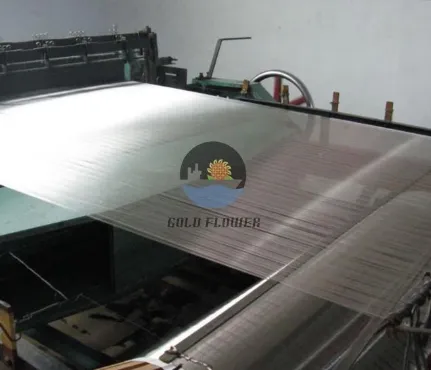kwi . 18, 2025 09:24 Powrót do listy
Woven Stainless Steel Mesh: Modern Materials That Combine Functionality and Aesthetic Value
Woven stainless steel mesh, A new type of material made by interweaving small stainless steel wires, with its unique physical properties and aesthetic characteristics, has been increasingly widely used in modern industrial and architectural design fields. It is not just a simple filtering or protective medium, but also a modern material that combines functionality and aesthetic value, capable of meeting diverse needs.

The excellent functionality of woven stainless steel mesh is the foundation for its wide application
The stainless steel material itself endows it with excellent corrosion resistance, wear resistance, and tensile strength. This enables the siatka druciana ze stali nierdzewnej to be used for a long time in various harsh environments without deformation or damage. In addition, according to different weaving methods and wire diameter sizes, the density and permeability of the mesh can be adjusted to achieve precise filtration effects, which are widely used in precision filtration in chemical, food, pharmaceutical and other fields. In the field of architecture, stainless steel wire grids can be used as structural components such as curtain walls and fences, providing protection while ensuring air circulation and creating a comfortable indoor environment.
The aesthetic value of woven stainless steel mesh cannot be ignored
Its metallic texture and unique weaving texture give it a modern and minimalist aesthetic. Different specifications, shapes, and colors of wire mesh can create rich light and shadow effects and visual layers, providing architectural designers with vast creative space. For example, by adjusting the density and direction of the wire mesh, the angle and intensity of sunlight can be controlled to create different indoor atmospheres. In terms of interior decoration, stainless steel wire cloth can be used as a partition, ceiling, and other elements to create a space full of modernity.
The application of woven stainless steel mesh also faces some challenges
For example, the production cost is relatively high, the processing technology is strictly required, and professional installation techniques are needed. In addition, for certain special environments, factors such as the conductivity and electromagnetic shielding performance of the wire mesh need to be considered.
In summary, stainless screen wire has become an indispensable material in modern industrial and architectural design due to its excellent functionality and aesthetic value. With the advancement of technology and continuous innovation in craftsmanship, we believe that its application fields will become more extensive, bringing more convenience and beauty to our lives. In the future, we look forward to seeing more innovative designs based on woven stainless steel mesh, achieving higher integration and breakthroughs in functionality and aesthetics.
Woven Stainless Steel Mesh FAQs
What is a woven stainless steel mesh?
Woven stainless steel mesh is a mesh material woven from stainless steel wires through warp and weft interweaving. It has a uniform mesh structure and is widely used in fields such as filtration, screening, protection, and decoration.
What are the main characteristics of a woven stainless steel mesh?
Corrosion resistance: The stainless steel material makes it suitable for humid, acidic and alkaline environments.
High temperature resistance: can maintain stability in high temperature environments.
High strength: It has good mechanical strength and wear resistance.
Diversified weaving methods: such as plain weave, twill weave, Dutch weave, etc., to meet different needs.
Easy to clean and maintain: reusable, long lifespan.
What are the main application areas of woven stainless steel mesh?
Filtration and screening: used for liquid and gas filtration in industries such as petrochemicals, food and beverage, and pharmaceuticals.
Architectural decoration: used for indoor and outdoor decoration, guardrails, and screens.
Protection and Safety: Used for machine protective covers, door and window protective nets, etc.
Agriculture: Used for breeding nets, fences, and screening equipment.
Electronics industry: used for electromagnetic shielding and heat dissipation networks.
What are the common weaving methods for woven stainless steel mesh?
Plain weave: The most common weaving method involves alternating warp and weft threads, with square mesh holes.
Twill weaving: interweaving warp and weft lines, with diamond shaped mesh holes, suitable for high-strength requirements.
Dutch weaving: The warp is thicker, the weft is thinner, and the mesh is conical, suitable for fine filtering.
Seat weaving: multi-layer weaving, suitable for high-precision filtration.
How to choose a suitable woven stainless steel mesh?
When making a choice, the following factors should be considered:
Mesh size: Choose the appropriate mesh size according to filtering or screening requirements.
Wire diameter: Choose the appropriate wire diameter according to the strength requirements.
Material: Common materials include 304 and 316 stainless steel, with 316 being more suitable for highly corrosive environments.
Weaving method: Choose plain weave, twill weave, or Dutch weave according to specific usage.
Work environment: Consider factors such as temperature, pressure, and chemical corrosion.
udział
-
What Are the Key Applications and Benefits of Chicken Wire Gabion and Related Retaining Solutions?
AktualnościJul.18,2025
-
What Are the Key Advantages and Applications of PVC Coated Gabion Wire Mesh and Related Solutions?
AktualnościJul.18,2025
-
Welded Gabion Mesh Solutions: Strength and Versatility in Construction
AktualnościJul.18,2025
-
Essential Solutions for Slope Stability: A Focus on Protective Nets
AktualnościJul.18,2025
-
Durable Solutions for Erosion Control and Construction: Galvanised Gabion Systems
AktualnościJul.18,2025
-
Constructing Functional Structures: The Art of Making Gabions
AktualnościJul.18,2025

